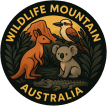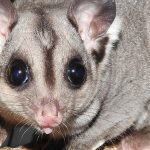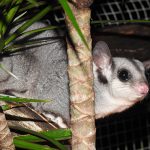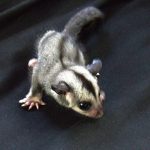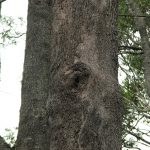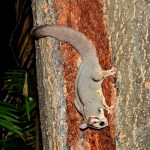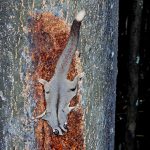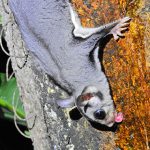SUGAR GLIDER
Petaurus breviceps
The Sugar Glider: Australia’s Tiny Night Glider
The sugar glider is one of Australia’s most enchanting small mammals – a creature that looks part-possum, part-squirrel, and part-flying toy, wrapped in soft grey fur.
Quick Facts
| Feature | Detail |
|---|---|
| Scientific name | Petaurus breviceps |
| Type | Small arboreal marsupial |
| Average body length | 12–20 cm (plus 15–20 cm tail) |
| Weight | ~90–150 g (adults) |
| Activity | Nocturnal (active at night) |
| Distribution | Eastern & northern Australia, Tasmania (introduced), parts of New Guinea |
| IUCN status | Least Concern (some local declines) |
What Does a Sugar Glider Look Like?
- A dark stripe from nose to mid-back, like a painted racing stripe.
- Large ears, thin and flexible, that swivel to catch the faintest sound.
- A long tail, often as long as its body, used for balance and steering in the air.
- A gliding membrane (patagium): a thin flap of skin stretching from the wrist to the ankle on each side.
When a sugar glider prepares to leap, it spreads its limbs out like a tiny parachute, and the patagium billows into a delicate wing.
The Art of Gliding
Sugar gliders cannot truly fly, but they are master gliders.
- They launch from a high branch, leap into the dark and spread all four limbs.
- The membrane catches the air, allowing them to glide up to 40–50 metres or more.
- They use:
- Tail: as a rudder to steer.
- Body tilt: to change direction.
- Tiny adjustments of their limbs: to slow down or speed up.
In a quiet Australian forest at night, you might never hear their landing – just a soft thud and the faint rustle of leaves.
Gliding helps them:
- Travel between trees without climbing down to the ground (where predators wait).
- Save energy compared with climbing.
- Move quickly between feeding trees.
A Marsupial, Not a Rodent
Sugar gliders are marsupials, like kangaroos and koalas. The female has a pouch where the tiny, jelly-bean-sized joey develops.
Life in the Pouch
- Newborns are blind, hairless and about the size of a grain of rice.
- They crawl into the pouch and attach to a teat.
- They stay in the pouch for around 60–70 days.
- After leaving the pouch, they spend more weeks clinging to mum’s back or staying in the nest.
Where Do Sugar Gliders Live?
Sugar gliders live in trees, rarely coming to the ground. You’ll find them in:
- Eucalypt forests
- Woodlands
- Acacia scrub
- Sometimes in plantations or farmland shelterbelts, if there are enough trees and hollows
They prefer areas with:
- Flowering and sap-producing trees (especially eucalypts and acacias).
- Tree hollows for sleeping and raising young.
- Overlapping tree canopies, so they can glide from one tree to another.
What Do They Eat?
Despite the name, sugar gliders are omnivores. They like sweet foods, but their natural diet is varied.
Main Foods
- Tree sap and gum
- They make small cuts in bark with their sharp lower incisors.
- They return later to lick the sticky sap.
- Nectar and pollen
- Particularly from eucalypts and native flowering trees.
- Insects and spiders
- Moths, beetles, and other small invertebrates, which provide protein.
- Occasionally:
- Small vertebrates, such as tiny lizards or bird eggs, if available.
Their diet changes with the seasons: more insects when they are abundant; more sap, gum and nectar in cooler months.
Social Life and Communication
Sugar gliders are highly social animals.
- They sleep in groups (often 4–10 animals) in tree hollows lined with leaves.
- Groups often include:
- A dominant male
- Several females
- Subadult animals
Communication
They interact with:
- Soft chattering and chirping calls.
- Hissing or crabbing sounds when alarmed or threatened.
- Scent marking:
- Males have scent glands on their forehead and chest.
- They mark branches, nest sites and group members to reinforce group identity.
Social grooming helps keep their fur clean and strengthens bonds within the group.
Night in the Forest With a Sugar Glider
At dusk, as the air cools and the scent of eucalyptus deepens, a sugar glider’s head emerges from a hollow. One by one, the group climbs out:
- They pause, sniff the air, ears flicking.
- The dominant male may mark the entrance and nearby branches.
- Then they launch into the darkness, gliding from trunk to trunk like drifting leaves.
You might see only a quick shape passing between trees, and then the soft lick of nectar being taken from a flower or the sticky sound of sap being tasted from a carefully cut groove in the bark.
Adaptations to Survive
Sugar gliders have a suite of special adaptations:
- Gliding membrane: allows efficient travel and escape from predators.
- Big eyes: excellent night vision to navigate in low light.
- Keen hearing: helps detect predators, prey and other gliders.
- Strong claws: for gripping bark and climbing.
- Flexible diet: allows them to survive in changing seasonal conditions.
- Torpor: in cold weather or food shortages, they can enter a short-term, hibernation-like state to conserve energy.
Sugar Gliders as Pets (and Why This Is Complex)
In some countries, sugar gliders are kept as pets, often sourced from captive breeding. In Australia, keeping native wildlife such as sugar gliders requires permits and is restricted or discouraged in many states, and wild-caught animals should never be taken from the bush.
Concerns include:
- Diet: Many pet diets are too sugary and lack proper nutrients.
- Social needs: They are naturally social and can suffer if kept alone.
- Space: They are gliders designed for tall forests, not small cages.
- Conservation ethics: The pet trade can encourage illegal capture where laws are weak or poorly enforced.
From a conservation perspective, sugar gliders belong most naturally in their forest homes.
Conservation Status and Threats
Overall, the species is listed as Least Concern, but local populations may be declining in some areas.
Main Threats
- Habitat loss and fragmentation
- Clearing of forests and woodlands for agriculture and urban development.
- Loss of large, old trees with hollows.
- Predation
- Climate change
- Changes in flowering patterns, insect availability and fire frequency.
- More frequent, intense bushfires can remove hollows and food sources.
Conservation Actions
- Protecting and restoring native forests and woodlands.
- Retaining old hollow-bearing trees.
- Planting corridors of native trees to connect fragments of habitat.
- Managing feral predators (particularly cats and foxes).
Similar Species and Confusion
Australia has several gliding marsupials in the Petaurus group:
- Squirrel glider (Petaurus norfolcensis)
- Larger than sugar gliders.
- Longer face and bushier tail.
- Yellow-bellied glider (Petaurus australis)
- Much larger, loud calls, distinctive yellowish belly.
- Greater glider (Petauroides volans)
- Not closely related, but another gliding possum; large, fluffy and mainly a eucalypt leaf eater.
How You Can Help Sugar Gliders
Even if you do not live in Australia, you can support gliders and similar wildlife by:
- Supporting organisations that protect forests and wildlife habitat.
- Choosing products that do not drive unnecessary deforestation.
- Learning about native species and sharing that knowledge with others.
If you live in Australia:
- Plant native trees and shrubs, especially local eucalypts and acacias.
- Keep cats indoors at night and manage pet impacts.
- Support policies that protect old growth trees and wildlife corridors.
